Nothing beats quality time on routes to improve your climbing performance. But why limit your physical and mental training to hours spent on the crags or in the climbing gym? By balancing out dedicated climbing practice with a focus on overall strength, stamina and health, beginner and seasoned climbers alike can achieve better results on the wall. We’ve compiled a list of eight activities that complement your climbing with the insight of experts including Eli Strauss, head climbing instructor at New York City’s The Cliffs at Long Island City.
8 Ways to Balance Your Climbing Training
1. GET WET

Whether your goal is to nurse an injury back to health, increase your core strength or up your endurance, a few laps in the pool will benefit your climbing.
The downward path the arms follow in swimming is similar to the reaching and pulling movements in climbing, “so those muscles get an even better workout,” Strauss says. And because swimming works “more or less every muscle group in a very low-impact environment, the injury risk is miniscule.”
By strengthening your back and abs so your fingers don’t have to do all the work, swimming can also help prevent common over-use injuries in climbing like tendonitis.
2. OM TO THE TOP
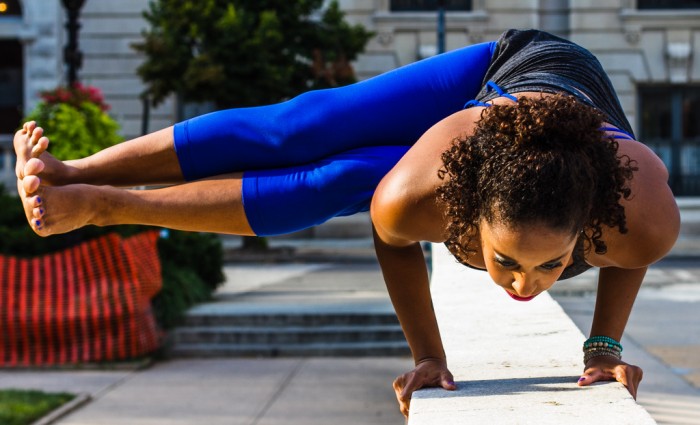
Climbing is not unlike yoga in that it’s often necessary to embrace unnatural positions in order to reach new heights – think hanging upside down or balancing on tiptoes to reach that crucial pinch.
But even between cruxes, a regular yoga practice is “one of the best things for rock climbers to do,” Strauss says. The most obvious benefit is increased flexibility. But flowing through gentle poses synced with controlled breathing also trains razor-sharp focus and works the antagonistic muscle groups. As a result, you’ll be stronger and less injury-prone in climbing.
Keep up at least a weekly practice to see consistent results. Your mind and body will thank you for it once you’re back on the wall.
3. WALK THE LINE
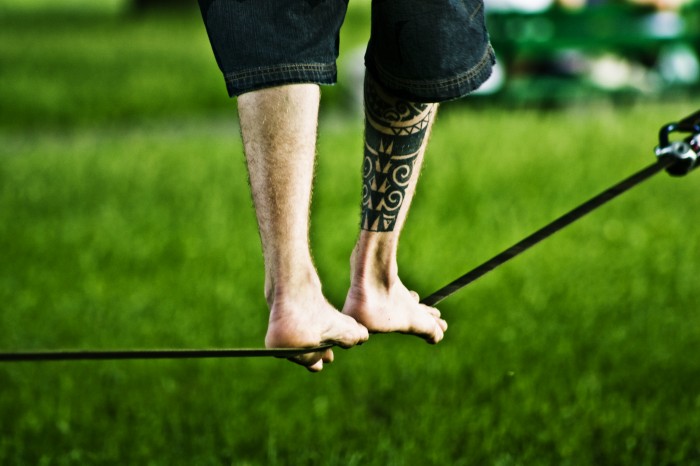
Slacklining is one of those activities that helps improve your climbing, but it’s hard to pinpoint exactly why. “The histories of the two sports have been linked more or less since rock climbing became a thing,” Strauss says.
There are as many versions of the roots of slacklining as there are modalities, but most accounts lead back to Yosemite Valley in the 70s. The Stonemasters, a group of “counter-culture guys” who pioneered rock climbing as it is known today started slacklining for fun, according to Strauss. Much like walking a tightrope, slacklining is a low-impact way to fine-tune your balance and basically “everything you need for climbing, just in a different capacity,” Strauss says.
If you’re trying it for the first time, fasten the line between two sturdy anchors like trees. First, practice keeping your balance on one foot. When you can stay steady for around 10 seconds, try taking a few steps. To up the thrill factor, rig the line over water (not too high!) and get creative with tricks like jumping, sit-walking or running.
4. HIT THE PAVEMENT
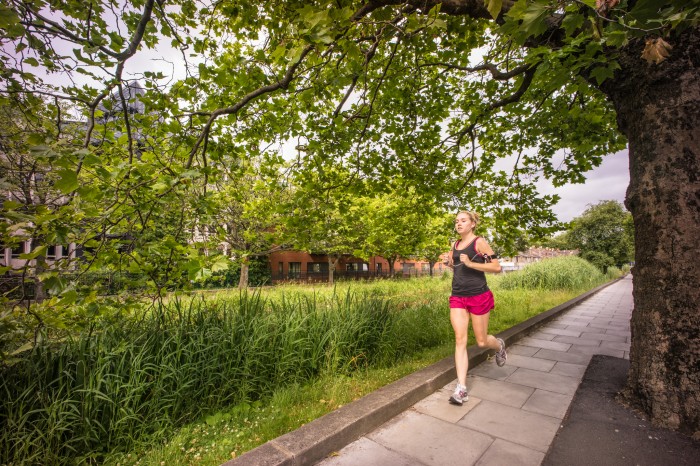
It’s common for climbers to neglect cardio activities like running or cycling. But improved aerobic fitness will translate to better results on the crags, especially on longer routes.
“Climbing is a very anaerobic sport,” Strauss says. “We don’t get winded in the same way, we don’t get our heartbeats up the same, we don’t get that endorphin rush. But having that level of conditioning and background is always advantageous because, more than anything, it allows you to recover faster and go longer.”
The best cardio workout for you depends on the nature of your climbing sessions, but some experts suggest spending 70-80 percent effort for periods of 25-35 minutes.
5. STRENGTHEN WITH CARE
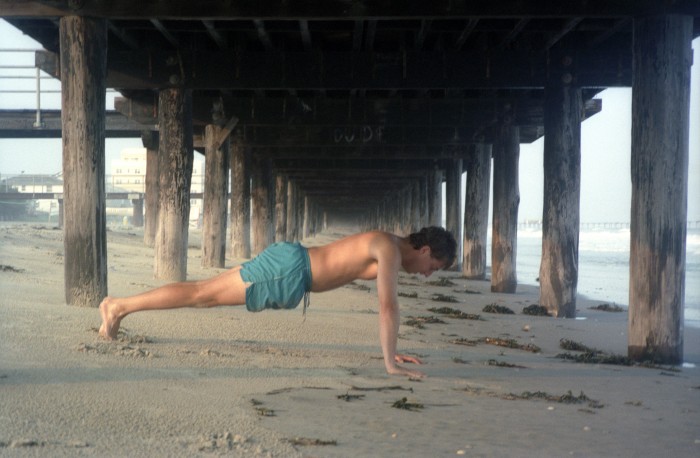
Round out your training plan with time focused on building climbing-specific strength through weightlifting and body-weight exercises like pull-ups, tricep dips and campus board.
“Because climbing is such a specific action, our cross-training turns out to be really specific as well,” Strauss says. Campus boards – wooden boards with rungs you climb up using only your arms – are “an awesome way to increase grip and strengthen over almost anything else,” he adds. But it’s also easy to get hurt. For beginners, just practice hanging on and holding up your body weight to start.
Budget a two- to three-month period in your training program for intense strength-training tailored to your climbing goals. Then, keep it up just enough to maintain the base you’ve built.
6. GET VERTICAL
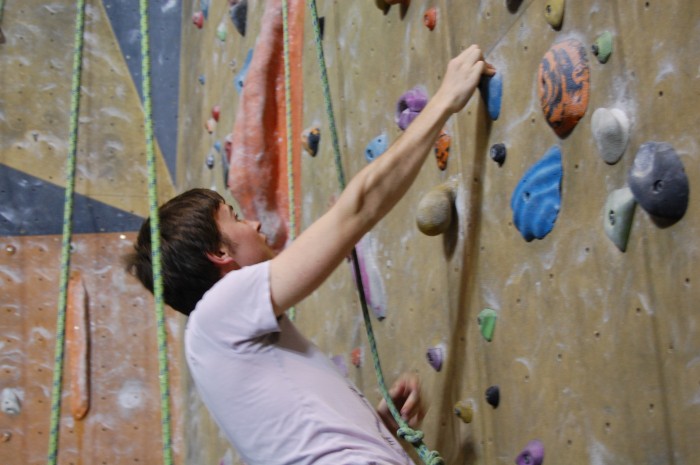
Although bouldering can seem like an easier, less intimidating way to start climbing than top-roping, Strauss recommends getting “used to your body vertical before you start trying difficult movements” that bouldering requires.
There’s no doubt that bouldering is fun and beneficial for your climbing. But because it’s also harder, progress is slower. “It’s hard to stay invested in a sport you don’t feel like you’re making progress in,” Strauss says. Spend time top-roping on easy routes, and you’ll soon be able to last longer and reach your goals in bouldering. In turn, you’ll build the strength and skills you need to start tackling more challenging routes on a rope.
To get started, choose an easy or familiar route and climb it three times as quickly as you can without taking breaks. Do a set of five, and then repeat the exercise on a few different routes. Got that down pat? Try it once more, but this time with your eyes closed!
7. TAKE IT EASY

Serious climbers can be reluctant to take more than a day off the rock for fear of getting weaker. But in reality, rest is one of the most important aspects of any training program.
“It’s a very fine line because a coaching cliché is you need to climb a minimum of three days a week to see constant improvement,” Strauss says. “But, especially as a beginner, you should not be climbing back-to-back days necessarily.” Rest doesn’t have to mean refraining from all types of physical activity, but from those that focus intensely on the same muscle groups as climbing.
On days when you do climb, don’t skip your pre- and post-stretching to help your body rest and rebuild. How long to rest depends on your training regimen, but experts suggest taking 24-72 hours between climbs.
8. FUEL UP

Because climbing is more of a lifestyle sport than one you get into for fitness, climbers tend to be less focused on overall conditioning and health than other types of athletes.
“Obviously the pros are paying very close attention,” Strauss says. “When we as amateurs want to get better at a sport, in any other sport we’re paying attention to what we eat, we’re paying attention to our weight, to our caloric intake and stretching.” Climbing should be no different.
The first step is being aware of what you’re eating and following general nutrition guidelines adapted to your needs. On climbing days, drink water before, during and after your ascent, and bring along a banana or other piece of fruit for a healthy source of fuel. When you’re done for the day, be sure to take in enough protein to ease your recovery.
- 5 of the Most Extreme (Ancient) Sports - 12 November, 2014
- 8 Ways to Balance Your Climbing Training - 23 October, 2014
- How to Improve Your Climbing - 2 September, 2014


Trackbacks